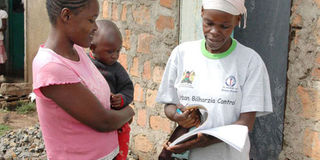Exposure to bilharzia linked to infant death

Ms Millicent Akinyi (right), a community health worker, attends to Jane Auma (left) during a community-wide bilharzia treatment at Nyalenda B area in Kisumu Town on October 27, 2011. PHOTO | FILE | NATION MEDIA GROUP
Children born to Bilharzia-infected mothers are at risk of dying from measles by age two, a new study by Kenya Medical Research Institute (Kemri) has revealed.
This is because such children have lowered immune response to measles, yet in Kenya children get the measles vaccine at nine months and their mothers’ immune response is too weak to protect them.
The antibodies responsible for fighting the disease in babies whose mothers had bilharzia were found to be low.
This meant that they couldn’t fight measles and were more likely to succumb to the disease. Mothers with bilharzia (schistosomiasis) were more likely to have anaemia because their haemoglobin levels are very low.
Bilharzia is a neglected tropical disease and in Kenya, about six million people are at risk of infection, with 70 per cent of them aged between five and 14 years.
There are three major endemic areas in along the coast, Lower Eastern and Taveta areas and the Lake Victoria Basin.
The Kemri study sampled 117 mothers and their newborns and followed them for four years.
Only ninety-nine of the expectant mothers, 42 who tested positive and 57 who tested negative comprised the final dataset for analysis.
The study was done at the Jaramogi Oginga Odinga Teaching and Referral Hospital, Kisumu Sub-County Hospital, Port-Florence, Ober Kammoth Health Centre, Usoma Dispensary and Rota Dispensary in Kisumu between 2013 and 2017.
Blood tests were done on infants and immunisation records kept.
INFECTION
Some of the children who were not infected with bilharzia when the study began got infected later because their mothers carried them along to the lake while fishing or washing clothes.
“The disease is associated with schoolchildren, but when infants are placed on infested water to play, the larvae take just five minutes to penetrate, hence why we found an infected six-month-old,” said Dr Maurice Odiere, the head of the neglected tropical diseases research unit at Kemri.
The researchers noted that pregnant women and children are under the age of five are left behind in the quest to eradicated the disease.
“The drugs that we currently use are big and cannot be swallowed by a small child.
“We have to crush them and they are very bitter,” said Dr Odiere, adding that there is need for a paediatric formulation.
While the World Health Organisation (WHO) recommends treating pregnant women for schistosomiasis with Praziquantel, they have been excluded from mass drug administration programmes because of concerns about potential effects of the drug on unborn babies.
The study recommended treating pregnant women for schistosomiasis to get the optimum efficiency of measles immunisation in children and to reduce anaemia in women.
To avoid transmission, the study advises people to avoid contact with fresh water including swimming, wading or other aquatic activities in water that may be infested with the parasites.
Water from freshwater sources used for drinking or bathing must be brought to a boil for at least a minute.
Allowing the water to stand for 24 hours or more before using it for bathing may also help prevent infection.
Vigorous towel drying after an accidental, very brief water exposure may help prevent the parasite from penetrating the skin.
***
BILHARZIA RISK
Schistosomiasis is a severe endemic disease that is transmitted when people suffering from the disease contaminate freshwater sources with faeces containing parasite eggs.
When the eggs hatch, the larvae released by freshwater snails penetrate the skin during contact with infested water causing blood loss and tissue damage.
People are often infected during routine agricultural, domestic, occupational, and recreational activities, which expose them to infested water.
People who are at most risk include those who so fishing, rice farming, car washing, sand harvesting since day-to-day activity exposes them to these waters.



